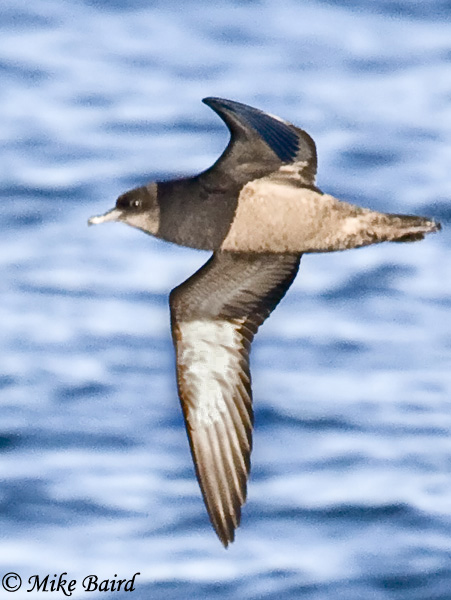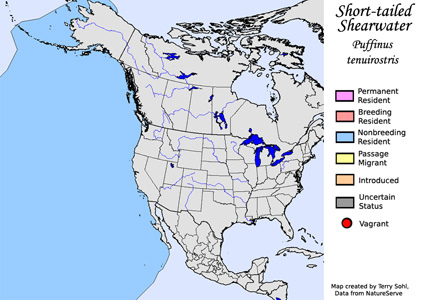| Length: 16 inches | Wingspan: 38 inches | Seasonality: Non-resident in South Dakota |
| ID Keys: Dark overall, short bill, very similar in appearance to Sooty Shearwater | ||
 The
Short-tailed Shearwater is a common breeding bird off the southeastern coast
of Australia, but they undergo a very long distance migration after the
breeding season. Some Short-tailed Shearwaters may be found as far
north as the Arctic Ocean north of Alaska during the Northern Hemisphere
summer. They are very similar in appearance to the
Sooty Shearwater. The American
Birding Association provides
this excellent reference
for distinguishing between the two species.
The
Short-tailed Shearwater is a common breeding bird off the southeastern coast
of Australia, but they undergo a very long distance migration after the
breeding season. Some Short-tailed Shearwaters may be found as far
north as the Arctic Ocean north of Alaska during the Northern Hemisphere
summer. They are very similar in appearance to the
Sooty Shearwater. The American
Birding Association provides
this excellent reference
for distinguishing between the two species.
Habitat: Found on islands off the southeastern Australian coast when breeding, as well as some parts of the mainland. Breeds in areas where grass and other vegetative cover is present, but with an underlying soil suitable for digging nest burrows. Outside of the breeding season, disperses widely at sea, but is mostly found over the continental shelf and in areas where upwelling currents are found.
Diet: Feeds mostly on fish, squid, and crustaceans. Will also sometimes feed on other marine life.
Behavior: Forages by swimming on the ocean's surface or flying low over the ocean's surface, and diving and swimming underwater to capture prey.
Nesting: The Short-tailed Shearwater nests in burrows, with a nesting chamber that is either barren, or sometimes lined with a bit of vegetative material. The female lays a single egg, and both parents help to incubate it. Upon hatching, both parents help tend to the young, feeding the nestling at night by providing regurgitated fish.
Song: Usually silent except on breeding sites, where they will make piercing high-pitched calls.
Migration: Short-tailed Shearwaters breed on islands off of southeastern Australia, as well as some locations on the mainland. They are strongly migratory, dispersing northward along the western Pacific in April and May, with some reaching as far north as the Bering Sea and Arctic Ocean. They begin moving back south again in August and September, although some non-breeding birds may be present in the north Pacific at all times of the year.
Interactive eBird Map: Click here to access an interactive eBird map of Short-tailed Shearwater sightings
Similar Species: Extremely difficult to distinguish from the Sooty Shearwater. Bill length is one distinguishing characteristic, with the Short-tailed Shearwater having a shorter bill than the Sooty Shearwater. The ABA provides guidance for distinguishing between the two species (click).
Conservation Status: While populations of Short-tailed Shearwater have been in decline, they are still very common in many areas and cover a wide geographic range. The IUCN lists the Short-tailed Shearwater as a species of "Least Concern".
Further Information: 1) Alaska Seabird Information Series - Short-tailed Shearwater
2) BirdLife International - Short-tailed Shearwater
3) BirdWeb.org - Short-tailed Shearwater
Photo Information: Photo taken by Mike Baird - January 19th, 2008 - San Luis Obispo County, California - Photo licensed under Creative Commons Attribution 2.0 Generic License
| Click below for a higher-resolution map |
 |
| South Dakota Status: Non-resident in South Dakota |
Additional Short-tailed Shearwater Photos (coming soon!!)
